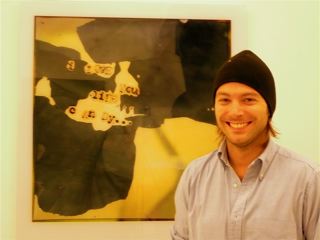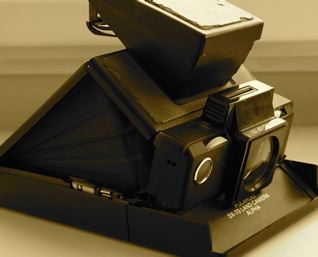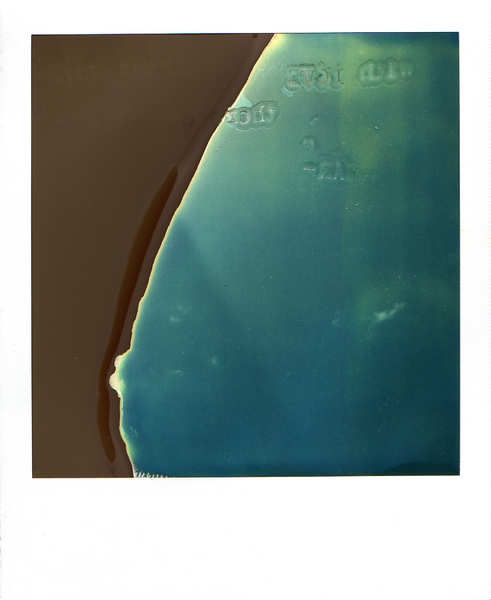
“It’s pre-conscious, more or less.”
When I asked Felix if I could have an interview with him, he replied, ” I can’t come up with any deep insights possibly…”
I told him not to worry. It’s not his or her words that makes the artist but his or her art. Except, of course, when you’re dealing with a poet…
***
Peter: Felix – why polaroids?
Felix: That’s easy. The story begins before I was born… My father gave a polaroid camera to my mother when she was pregnant – just shortly before I was born. He wanted her to take baby pictures with it. And so she did. She still has those pictures. Me as a baby. And my mother gave the camera to me. It’s actually the very same camera. The camera I take most of my pictures with nowadays. I discovered this funny contraption as a boy, with those funny flashbulbs to plug on… I loved to use those flashlights. And then I forgot all about it… to discover the SX-70 again in… 1999, when I moved to Hamburg. It was like meeting an old love – and falling in love again. So I bought some films, and I began to take pictures. Back then it was still easy to get hold of polaroid films. I like the idea that, originally, this camera was purchased to take pictures of me as a baby – and now I’m taking pictures with it.
Family property: The SX-70…
Peter: I see… family property, so to speak… When did you begin to mistreat your polaroids – to abuse them?
Felix: Only recently. I have to make a little digression here… I had been taking polaroids for eight years – polaroids without the special treatment. No additional processing, back then. Except that I liked to arrange them in sets of four. For a show, for instance. I used to be quite content with that. But I’ve always been in love with typography – without being an expert on the subject, though. But I love letters, the shape of letters… and typewriters. I love old typewriters. My father gave this ancient, malfunctioning Regina with its dry ink ribbon to me… another piece of family heirloom.
Family heirloom: Regina, ca.1915…
Then, back in 2006, I did those four images of the sky over Hamburg… the sky sequence (http://www.artdoxa.com/users/felix/artworks/750). I thought they were just great – except there’s not much on them. So I felt the need to add just another element. Maybe just because polaroid pictures of the sky can be so bland, so banal. So artlessly artsy, in a way… And the film was way past its sell-by date! So they looked just a little too much like fashionable retro chichi polaroids… However, it somehow occured to me to place them in my vintage typewriter. I just deftly tore out the ink ribbon before – and then I punched away at the keys with all of my strength… The print appears partly mirror-inverted. Without thinking I introduced another essential, constituent ingredient of my images. A way of capturing something and expanding into another dimension. The wording emerges at the same time as the image. Simultaneously. Practically no time elapses between shooting and typing. For as soon as the polaroid’s developed, it’s over – you won’t get that special appearance any more, that special surface effect of the printing. Because the chemicals have dried in the meantime. You know, it takes three to five minutes before you see anything at all. As a rule, I put the picture in the typewriter only seconds after exposure. You see, I print the words without actually seeing the picture. Naturally, I keep a mental picture of the shooting. The wording, the image… same time, same moment. It’s a package. A significant, unbroken unity. The wording, the script – it is not preconceived or premeditated. I like to, well, challenge myself. I’ve prepared the image by absorbing and visualizing certain ideas. Taking a picture – that’s my implementation of those ideas. And the picture goes into the typewriter right away! I just start to type. Spontaneously. I just do it. It’s a risk. The result could be plainly ridiculous, as a matter of course. It’s funny, but this just doesn’t happen. Well… it happened once. You know the pictures in question? You’ve seen them… It happened because I had left the wording to somebody else. When I was supplied with words by somebody else. By phone. By somebody who couldn’t see the pictures, couldn’t feel the pictures. It was an experiment. And it didn’t work out so well. I couldn’t achieve the integration. That’s what I’m looking for – integration. The pictures just didn’t assume the desired wholeness.
Peter: Like a dummy text…
Felix: Exactly. It just doesn’t work.
Peter: So you absorb something, incubate something… ideas, stimuli… but then, when it comes to the words, it’s all spontaneous?
Felix: In nine and a half out of ten cases I don’t reason when I’m writing. My lettrisme – now this sounds like it’s esoteric mysticism, New Age… It’s pre-conscious, more or less.
Peter: I see… you aren’t writing – it is writing… while you aren’t even seeing the image yet, while you are waiting for the image to emerge…
Felix: The image is still in my mind, for I’ve just taken it. You know, I take my time to look through the view finder… I’m looking for the perfect section, the perfect detail. Well… looking at some of my abstract intermediate forms, you may ask yourself, where is that perfect section? Where’s the composition? The volition? But yes… image section, detail, exposure…that’s a process of deliberation, a deliberate choice. Particularly when I’m using time exposure to capture movement, motion. To get a cinematographic, free and associative surface.
Peter: Sometimes you open up another image level by violating the white frame (http://www.artdoxa.com/users/felix/artworks/10094) or the plastic surface of the polaroid (http://www.artdoxa.com/users/felix/artworks/5320).
“Analog photoshopping…”
Felix: That’s a recent development. I’m going to reveal all of my trade secrets here… but since the concept of original ideas doesn’t any longer exist in postmodernism… Though I haven’t seen anything like my stuff anywhere else yet… Let me tell you as much – I use a paperknife on the photo. To strip and skin. A polaroid consists basically of two layers, negative and positive. Once you’ve pushed the button, the two layers are pressed together and react. They’re processed. There are ways to manipulate this process chemically or mechanically. And sometimes bits of the white frame – which is in fact aluminum foil – just stick to the roll, when I’m forcefully mangling the photo through the typewriter. It’s a very manual thing. Very handcrafty. Analog photoshopping. But this is how I get a complex and comprehensive image, which is nonetheless readable, intelligible.
Peter: And the sky series, they were the very first pieces you created in that fashion?
Felix: All four of them. It started as an experiment. I showed them to Jochen, my… ah… mentor… Hey – what do you think of this? And lo! The master approved. After a bit of consideration, that is…
Peter: Well, good for you… Next time, I want to hear from you all about the technical hazards of taking screenshots of internet porn and related issues… okay, this is where we take our intermission…
Felix Adelmann: “sky” — Photography: SX-70, typewriter, 2007
***
Portrait of Felix Adelmann by Peter Bies. © All rights reserved.
All the other photos by Felix Adelmann. © All rights reserved.




like Felix works very much
Felix,
great insight.
great interview peter. i like this transparency in working processes so much.
REGINA…”analog photoshopping”
the medium is the message.
you’re working beyond
michael
Well, I love the immediacy that a polaroid gives a subject. I particularly like Felix’s use of the typewriter and the disturbance of the sanctity of the surface of the polaroid and the margin. As much as photography is about time and memory, it is easy to get lost in the subject of the photo whereas your technique forces the viewer to examine the surface in a 3-d kind of way.
I already said enough, so for now all i will say is..: thank you giulio and Michael B for your comments, thank you Michael P for your continuous, constructive comments and feedback and thank you Peter for translating the untranslateable and thanks to everyone for their support………felix